The Ultimate Guide To Integrating Abstract Art Into Your Home Décor
Your home is the one place that should never perform for anyone. It should reflect you, not the Pinterest version of you, not the version curated for guests, but the version you are when you’re finally off, finally quiet, finally present. Most people design spaces to impress others. But what if your space was designed to hold you?
Abstract art is a powerful way to shift that focus. Not because it “adds a pop of colour,” but because it rearranges a room’s emotional frequency. A single piece can ground a space. It can soften the sharp edges of a room, and of a life. When chosen with intention, abstract art doesn’t decorate. It directs. It changes how you move through your space. It reminds you that your home can be more than functional. It can be a place of emotional recovery. Of return.
I began painting in a period of quiet collapse. I wasn’t looking to create something to sell. I needed to survive. Colour became the only thing that didn’t lie to me. Over time, the work changed. It got braver. Softer. Quieter. And so did I. Now those pieces live in spaces that want that same kind of honesty, not because they match the curtains, but because they carry presence.
This guide is not about matching art to a sofa or picking colours from a seasonal palette. This is about how abstract art, chosen and placed with emotional clarity, can change how you inhabit your space, and in turn, how you inhabit yourself.
Let’s begin where the art begins: not with style, but with why.
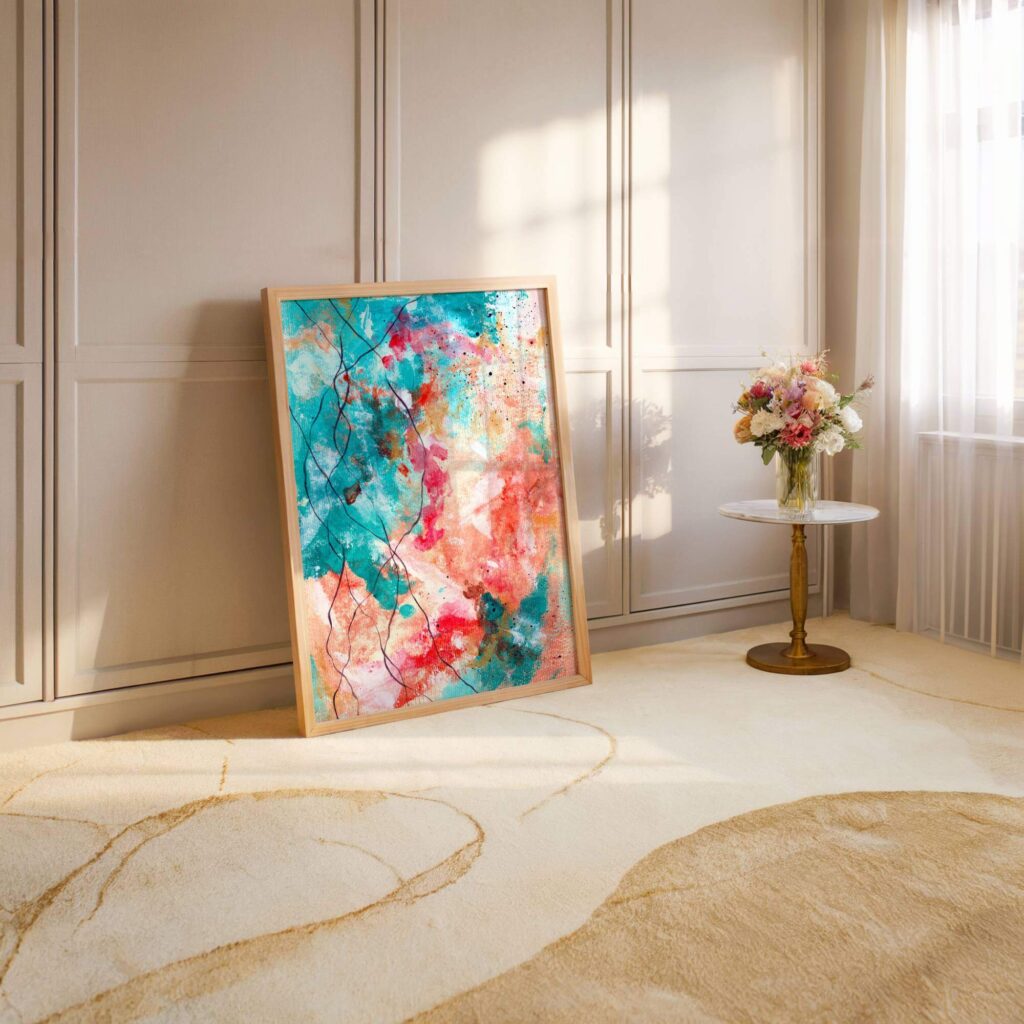
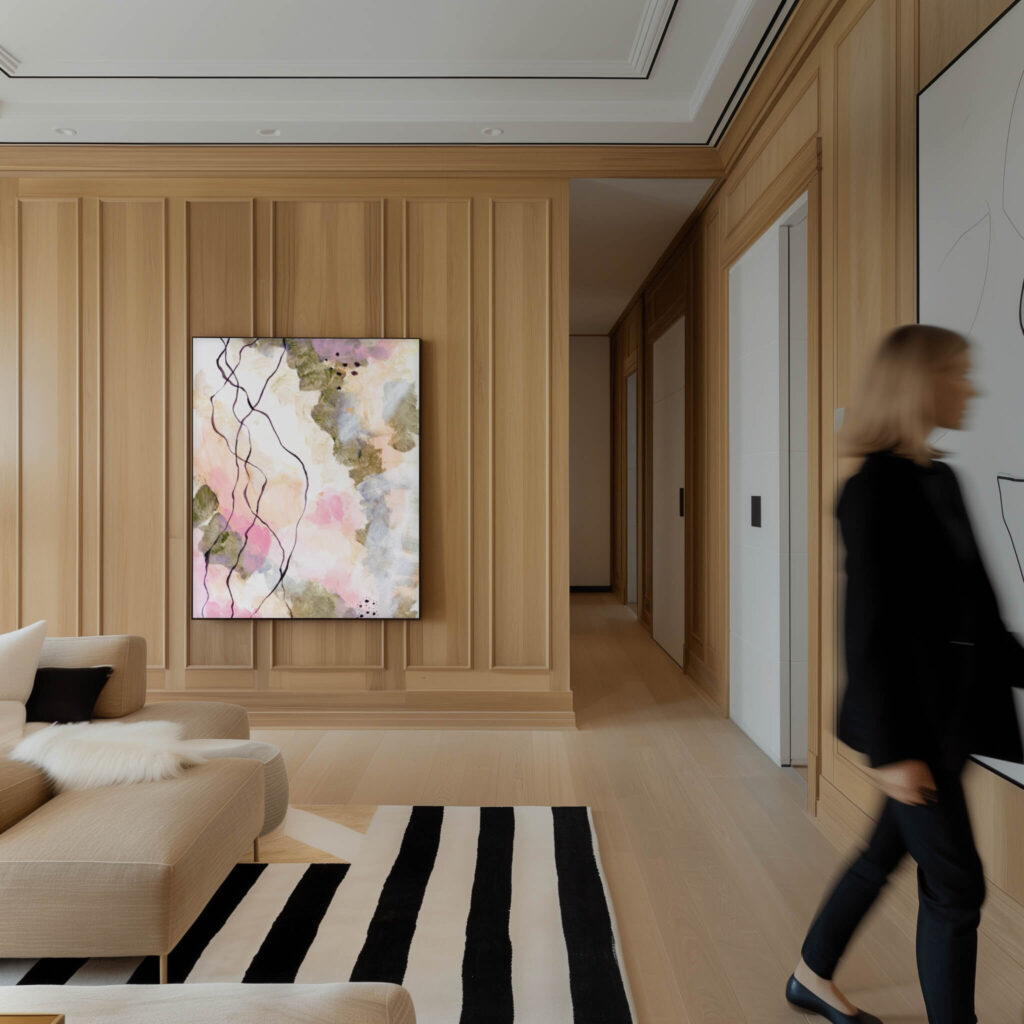
Understanding Abstract Art: A Canvas Of Creativity
What Is Abstract Art?
Why Does It Work So Well In Homes?
Because homes are emotional spaces. They’re not static. A living room holds grief in the morning and laughter by night. Your bedroom might be your sanctuary on some days and your battlefield on others. The energy changes. Abstract art allows for that fluctuation.
It also softens rigidity. You don’t need to match it to your furniture. It rarely competes with what’s around it. Instead, it moves with the space. It adapts to lighting. It responds to time of day. It becomes something closer to a presence than a possession.
And perhaps most importantly, abstract art doesn’t demand anything from you. It doesn’t tell you how to feel. It doesn’t require you to get it. It simply meets you where you are. That’s rare. That’s powerful. And that’s why more and more people are turning to abstract art when they want their home to feel not just styled, but human.
Why Embrace Abstract Art In Your Home?
Because your home should feel like it belongs to you. Not just your body, your emotions. Your moods. Your experiences. Your memories.
Abstract art holds all of that without needing to literalise it. It becomes part of the atmosphere. The backdrop of your thoughts. The rhythm of your day.
Unlike most decor choices, abstract art holds the tension between control and freedom. You can choose the palette, the size, the form, but you can’t control what the piece will make you feel over time. That’s its power. It keeps revealing. It keeps unfolding. It matures with you.
It Works With Every Design Style, But Doesn't Depend On Any Of Them
Minimalist interiors? Abstract art adds depth. Maximalist spaces? It offers breath. Earthy palettes? It echoes them. Cool modern greys? It warms them.
No matter what your style is, abstract art can either blend or contrast. And because it doesn’t depict a specific object or scene, it won’t date. It won’t go out of fashion. It becomes part of your space’s emotional infrastructure.
It Invites Conversation Without Demanding Attention
In social areas like living rooms or dining rooms, abstract art becomes a soft focus — something people are drawn to, but not in an intrusive way. You’ll notice guests drift toward it. Not because it shouts. But because it feels like something worth being near.
And in quiet spaces, bedrooms, therapy rooms, reading nooks, it becomes a companion. Not loud. Not needing to be understood. Just there. Just holding.
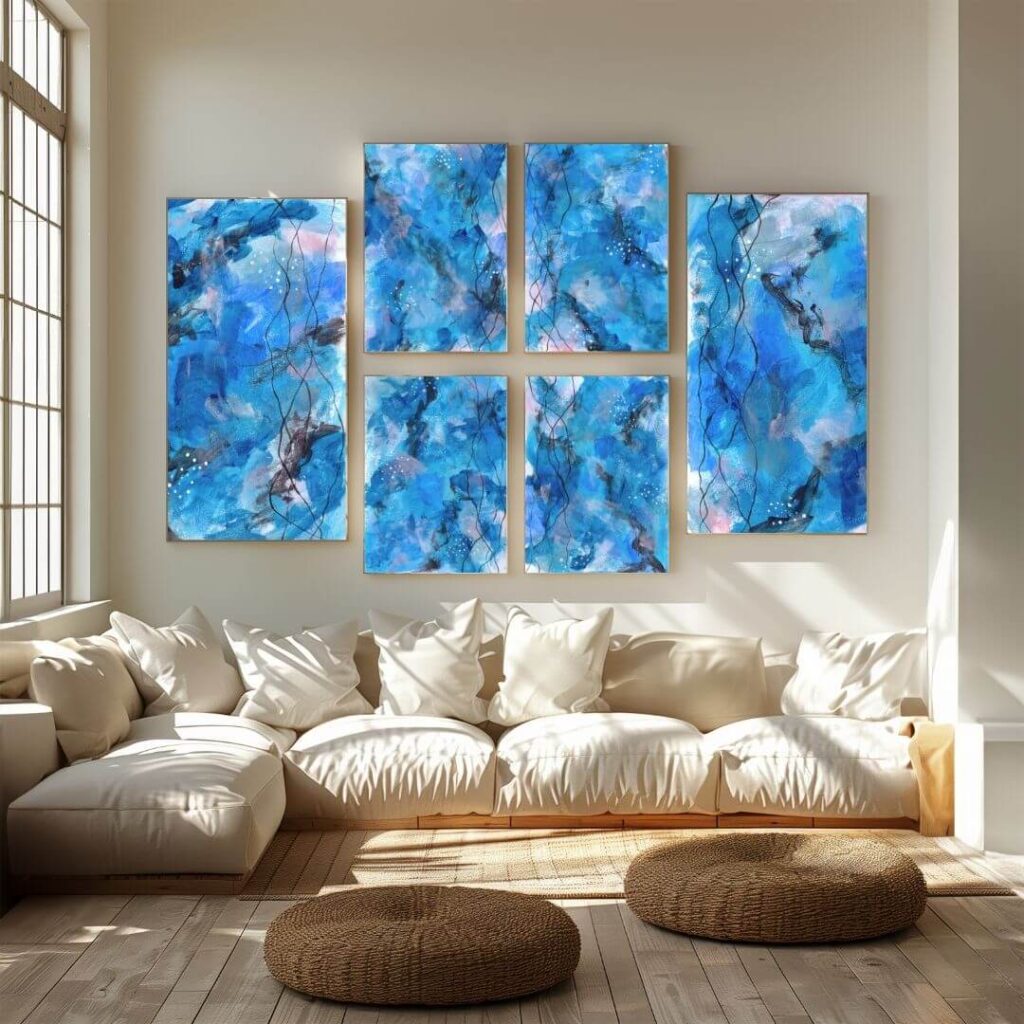
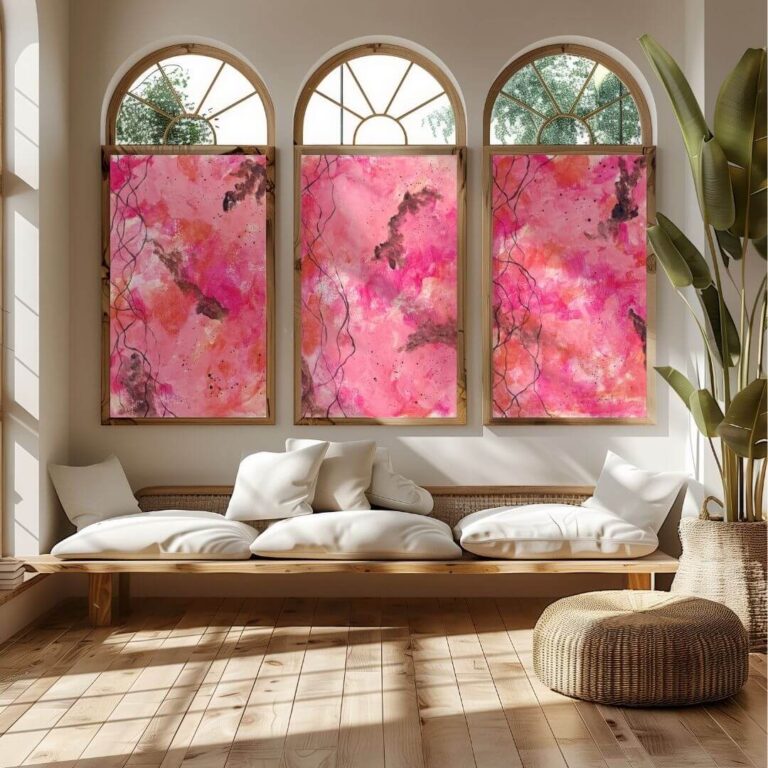
How To Start Exploring Abstract Art
If abstract art is new to you, or if you’ve only ever seen it in passing on gallery walls, Instagram, or Pinterest, you might feel like there’s a barrier to entry. There isn’t. You don’t need to be trained to appreciate it. You don’t need to know the terminology. You only need one thing: presence.
Let’s be honest, most of us weren’t taught how to engage with art. We were taught to judge it. To rank it. To figure out what it’s “meant to be.” But abstract art doesn’t ask to be solved. It asks to be felt. That means you can start exactly where you are.
Here’s how:
Visit Physical Galleries, But Do It Differently
Don’t go to a gallery to be educated. Go to feel. Pick a day when you’re not in a rush. Walk in without an agenda. Let your body tell you when a piece resonates. Stay there. Breathe. Ask yourself what it reminds you of, not visually, but emotionally. Does it feel like hope? Quiet? A memory?
Then walk away. Come back. See if it still holds the same weight.
One way to know a piece is right for you? It keeps showing up in your thoughts days later. That means it’s not just a good painting. It’s a mirror.
Use Online Platforms, But Look For Artist-run Ones
Large sites like Artsy and Saatchi are great for range, but they can also be overwhelming and impersonal. If you want work that speaks to you, try going deeper into the search. Look for individual artists’ websites, especially ones who speak openly about their process, themes, or emotional anchors.
And don’t be afraid to reach out. The art world has long made people feel like you need permission to ask questions. You don’t. If an artist is worth collecting, they’re likely worth talking to.
Try Temporary Placements
If you’re not ready to commit to a piece long-term, explore options like short-term rentals, digital previews, or even custom mock-ups. Some artists (myself included) offer virtual placement previews so you can see how a piece lives in your space, not just visually, but emotionally.
This takes it out of the abstract, ironically, and places it in your lived environment. From there, you’re not guessing. You’re experiencing.
Common Misconception: Abstract Art Is Meaningless
Let’s name it plainly: this is the most outdated and intellectually lazy argument people make about abstract art.
The idea that abstraction is “just scribbles” or “childlike” usually comes from a fear of not understanding it, or not being able to control the experience it gives. Abstract art resists certainty. That’s what makes it powerful.
Meaning Doesn’t Have To Be Literal To Be Real
Most of us were taught to associate meaning with objects. A painting of a dove means peace. A sunset means calm. A crying woman means sadness. But life, actual life, is rarely that clean.
Grief can feel like static. Joy can arrive with confusion. Stillness can look like nothing, but feel like everything. Abstract art has the range to hold those contradictions. It doesn’t need to say, “This is what I’m about.” It says, “Here. Feel what you need to feel.”
And that kind of meaning is personal, not universal. Which is precisely the point.
My Own Work Is Full Of Intention, Even If You Don’t See It At First
When I paint, I’m not decorating. I’m documenting. The colours I choose, the motion of the lines, the negative space, all of it carries something I’ve lived. Sometimes I know exactly what it is. Sometimes I only understand months later.
Some of my pieces were painted after running up hills until my lungs burned, trying to find silence in motion. Others were painted when my body had nothing left, and stillness became survival. You won’t find that in a gallery label. But it’s in the work.
And that’s true for many abstract artists. Our pieces aren’t just “aesthetic statements.” They’re embodied experiences. They’re quiet emotional records. If you stand long enough with the work, and let yourself be open to it, that intention begins to show up. Not through your eyes. Through your gut.
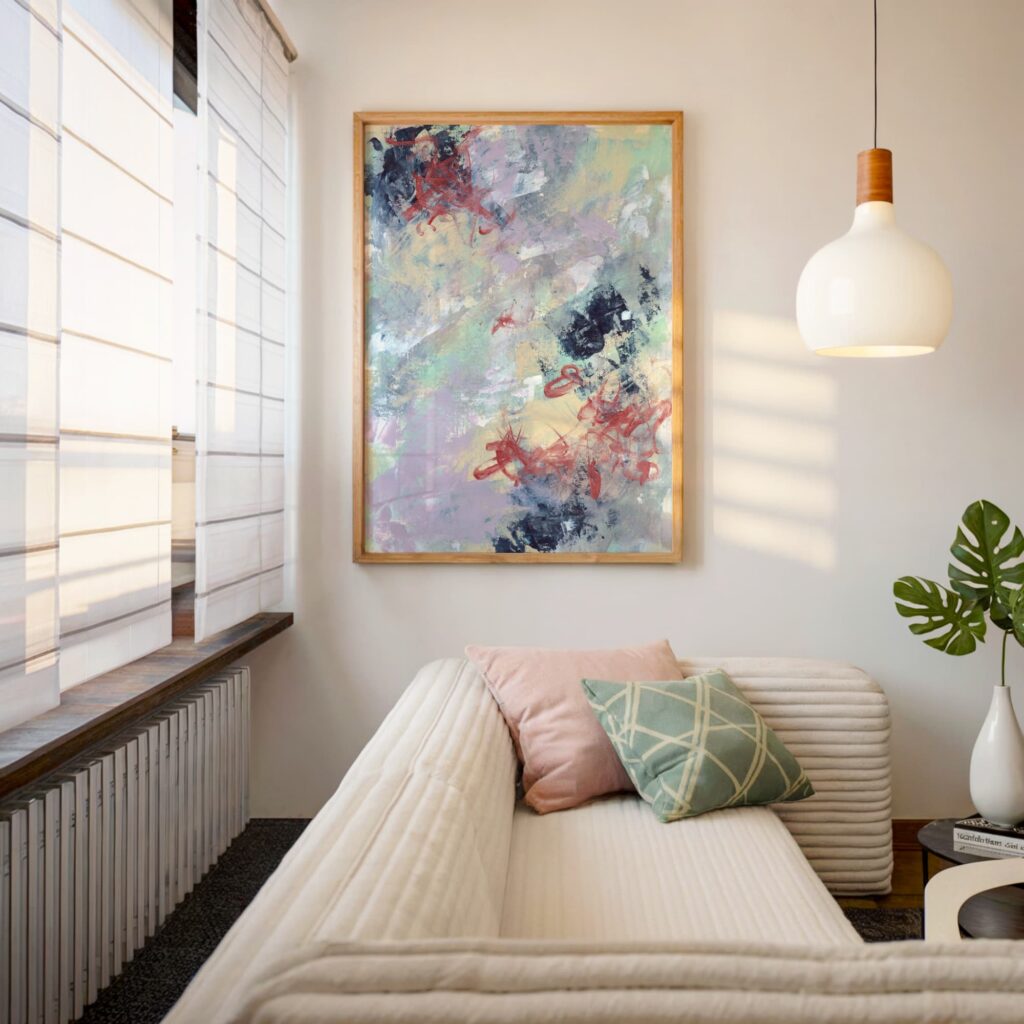
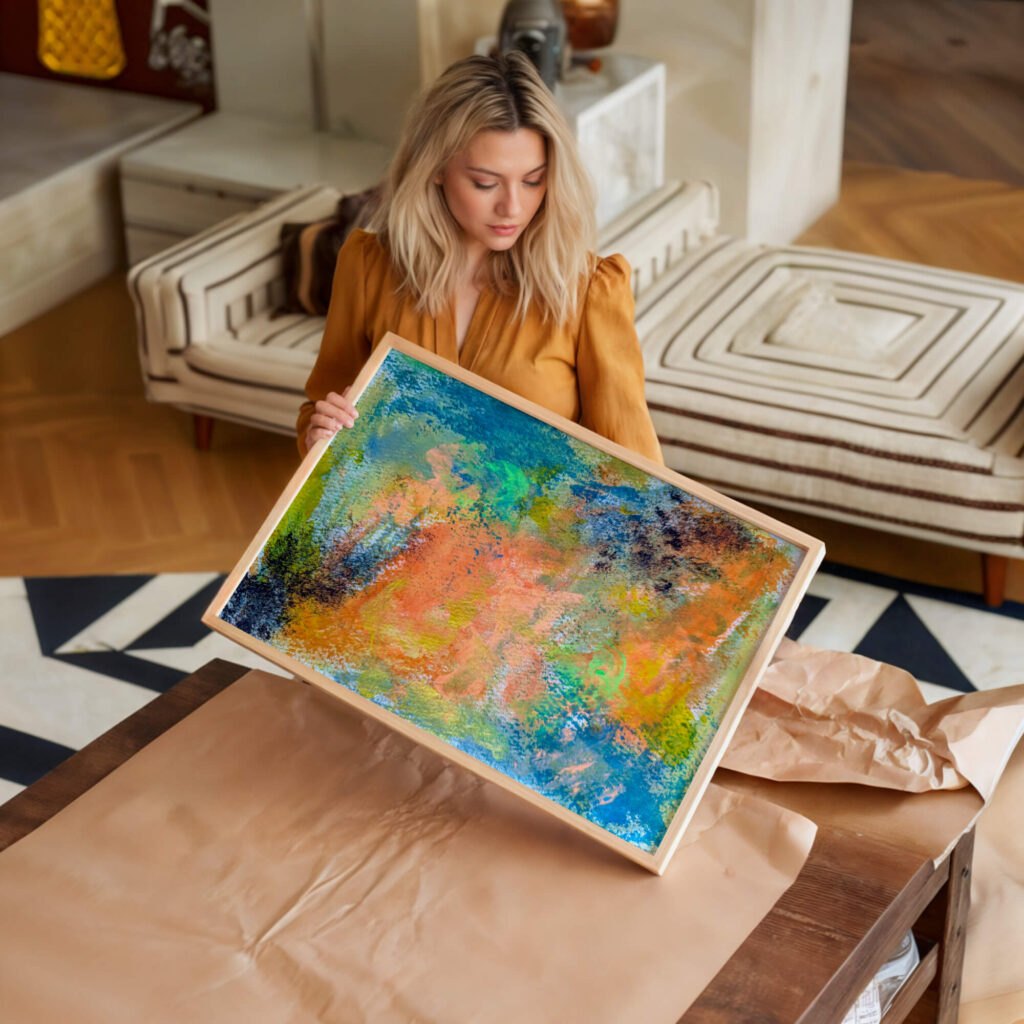
Choosing The Perfect Abstract Art For Your Home Or Commercial Space
Let’s cut through the design advice noise for a moment.
Choosing the “perfect” piece doesn’t mean the most expensive one. It doesn’t mean the one a designer tells you is on trend. It doesn’t mean what fits the current season’s palette.
The perfect piece is the one that changes how the room feels. Not just how it looks. You’re not buying a mood board. You’re creating a frequency shift in the room. And that shift should match something real in you, or in the people who will live, work, or recover in that space.
Align Art With Your Personal Style
Personal style doesn’t mean aesthetic identity. It means emotional priority.
What matters more to you, softness or structure? Energy or depth? Stillness or stimulation? There’s no wrong answer, but you need to know what matters most in that space.
Some questions to ask yourself before choosing a piece:
What emotional tone do I want this room to hold when no one’s speaking?
Is this space meant for rest, renewal, focus, or expression?
Do I want this piece to comfort me, challenge me, or keep me company?
Now let’s get into the practical side.
Evaluate Your Space
Before you choose a piece, take a real look at the room. Not just the wall space, the furniture, the light, the flow of movement. Where does your eye naturally land when you walk in? Where do you want it to land?
Make note of:
Natural light sources and how the light moves through the space during the day
Dominant materials (wood, metal, glass, soft textures)
Core tones already present (even if neutral)
This gives you the architecture of the room’s emotional DNA. Once you understand that, you can decide whether the art should amplify it — or disrupt it in a way that brings clarity or balance.
Choose Complementary Or Contrasting Colours
This isn’t about matching. It’s about relationship.
If your space is already visually rich, your piece can act as a visual pause. If your space is soft and quiet, your piece can energise. It doesn’t need to “blend in”, it needs to belong emotionally.
Tip: Choose one or two tones already present in the space, then find a piece that holds them, even if buried deep, within its palette. The human eye will pick up on those echoes and feel cohesion even when the piece is bold.
Also consider undertones. A space with warm beige might not pair well with a blue that leans icy. But it might pair beautifully with a blue that has a smoky, grey base.
Don’t look for perfect matches. Look for quiet resonance.
Create A Mood Board
Yes, it’s practical. But also, it gives you something important: perspective.
You’re no longer making decisions in isolation. You’re seeing how art relates to furniture, textures, materials, and the flow of the space. It helps you spot what’s missing, or what might overpower the whole room. You can do the exact same thing as interior designers do, with a selection of furniture, texture and art pieces (and everything else) to curate your perfect space.
You can build these digitally with tools like Canva or Milanote. Or go analogue and print the images. Physically cut and place. Feel it. Trust your hands, not just your screen.
Once you build 2–3 variations, walk away. Come back the next day. See what still holds.

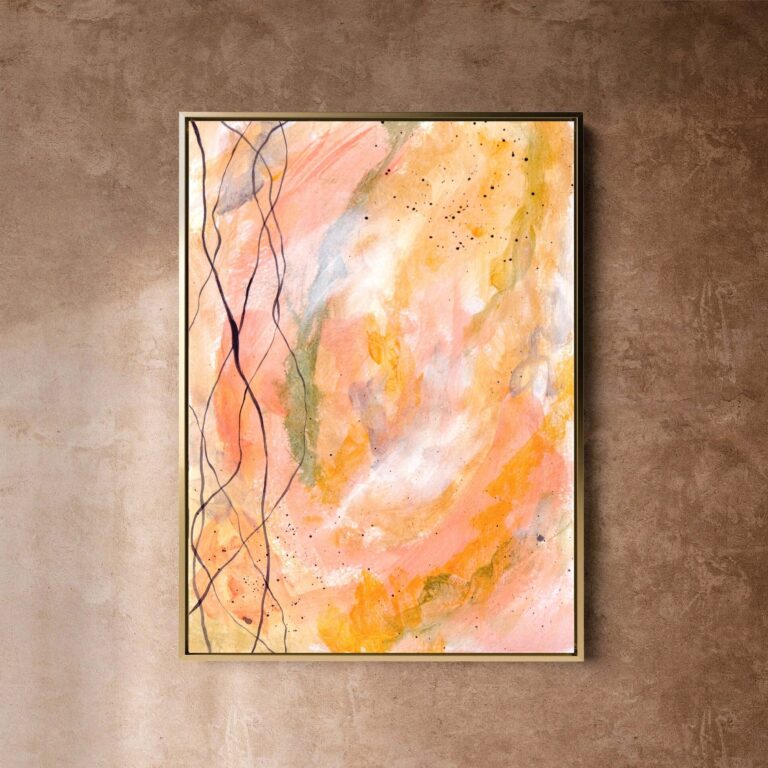
Consider Art Size And Scale
Most people underestimate just how much scale impacts a room’s emotional energy. A small piece on a large wall doesn’t feel intimate, it feels lost. A piece that’s too large in a confined space doesn’t feel bold, it feels overwhelming.
It’s not about how big your wall is. It’s about how much visual weight the room can hold.
Here’s how to think through it:
-
-
For large rooms with high ceilings: a single large piece creates grounding. It acts as an anchor, holding the energy of the room in place.
-
For medium-sized walls: consider diptychs or triptychs. Two or three related pieces side by side that create narrative or rhythm.
-
For small or narrow walls: go vertical. Tall, narrow pieces elongate the space and draw the eye upward, especially useful in hallways or entranceways.
-
Practical tip: use painter’s tape to block out the shape of the artwork directly on your wall. Live with it for a few days. See how it feels. The body knows when something is too much, or not enough.
Choose Art That Sets The Mood
This is where abstract art becomes powerful. Because it doesn’t show you a specific scene or object, it creates space for emotional direction. You can deliberately select pieces that change how the room feels, not by depicting anything, but by shifting the atmosphere.
For bedrooms or meditative spaces:
Think softness. Undulating lines. Gentle gradients. Neutral or cool palettes. These spaces are for restoration. Let the art hold silence. Don’t make the piece compete with the purpose of the room.
Examples:
A piece with watery brushstrokes and desaturated tones
A fluid, low-contrast composition with plenty of open space
For living rooms or social zones:
Think vibrancy. Energy. Movement. These are spaces of life and interaction. A bold piece can create a focal point and set the emotional tempo of the room.
Examples:
Pieces with punchy reds, oranges, or unexpected colour combinations
Sharp, dynamic marks that suggest rhythm or flow
For home offices or studios:
Think clarity. Focus. Forward momentum. A well-placed abstract piece here should keep your mind engaged but not overwhelmed.
Examples:
Pieces with structured compositions, geometric forms, or directional movement
Cool or jewel-toned palettes that keep the brain switched on
Placement Tips For Maximum Impact
Where you place your art matters just as much as which art you choose. You could have the most resonant, beautifully crafted piece, but if it’s shoved into the wrong corner, it’ll never hold its power.
Placement isn’t about decoration. It’s about honouring energy. Art shifts the emotional architecture of a space. So you don’t just hang it where there’s a gap. You place it where it can breathe, guide, and hold presence.
Here’s how to think about that.
Let The Piece Lead
Before you even pick a wall, ask yourself: what role do I want this piece to play?
Does it need to ground the room?
Do I want it to spark conversation?
Should it offer quietness, a visual exhale?
Or is it meant to invite curiosity, make people pause?
Once you know its emotional job, the placement becomes clearer.
Anchor It To Something Physical
Art floats without an anchor. You want it to feel intentional, not arbitrary. So place it in relationship to something already carrying visual weight in the room.
This could be:
A fireplace
A large sofa
A dining table
A staircase wall
A bed frame or headboard
A window with strong architectural lines
This doesn’t mean it has to be symmetrical. It means it has to relate. Think of it like conversation. The art is speaking to the object, echoing, contrasting, or supporting it. That’s where the balance comes from.
Use Natural Sightlines
Where does the eye naturally go when someone walks in? That’s your emotional entry point. If you place art there, it becomes the emotional keynote for the space.
Stand at the entrance of the room. Or better, walk into it fresh after being away. Where do your eyes go first? That’s your power zone.
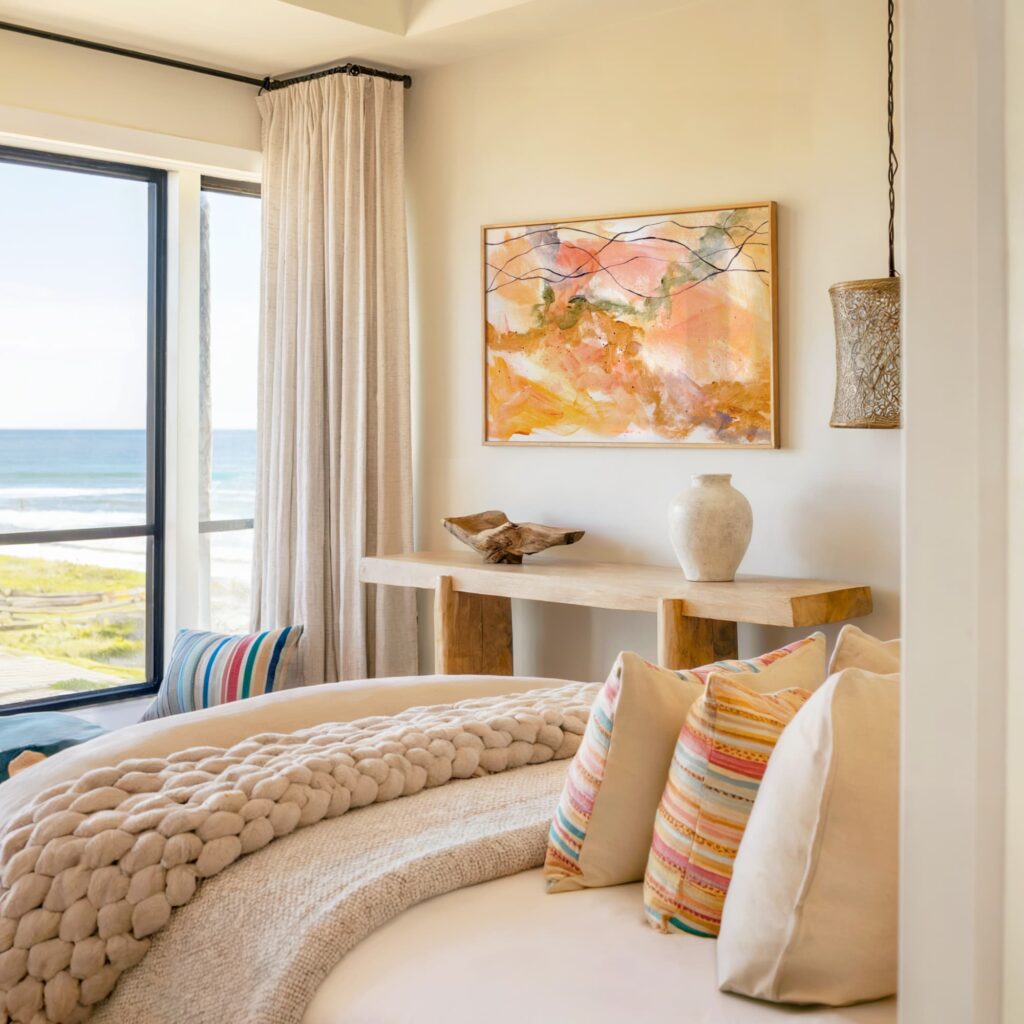

Use The Right Height And Spacing
Let’s talk about the most common design mistake: hanging art too high. This happens constantly. And it almost always kills the intimacy and power of the piece.
The Rule Of Human Sight
Standard gallery height is 150 to 160 cm from the floor to the centre of the artwork. Why? Because that’s where most people’s eyes fall. Hanging at this height creates instant connection. Anything higher and people are craning their necks. Anything lower and it disappears under visual clutter.
Important: This is a guideline, not gospel. For oversized works, or rooms with unusual dimensions, adjust accordingly. But always make your decision based on the feeling it creates, not just the metric.
Spacing For Gallery Walls or Diptychs
If you’re hanging multiple pieces, keep them visually cohesive by:
Spacing them 5 to 10 cm apart
Aligning their vertical centre lines (not just their tops)
Using consistent frames or matting (if applicable) to reduce noise
Try mocking it up first. Painter’s tape is your friend here. Tape out the outlines on the wall before you hammer anything in. Live with the shapes. See if the rhythm feels natural.
If it feels chaotic or too regimented, step back. Adjust. Your eye will tell you.
Complement With Lighting
This part gets overlooked constantly. But lighting is what gives abstract art life. It brings texture forward. It highlights brushstrokes. It lets depth emerge.
General Rules
Never rely solely on ceiling lights. They’re too diffuse.
Avoid direct sunlight unless the piece is UV protected.
Use directional spotlights or adjustable wall washers.
Consider dimmable options, different lighting levels can reveal different moods in the same piece.
Lighting isn’t just about visibility. It’s about atmosphere. Think of it like tuning a musical instrument. Too harsh and the emotion disappears. Too soft and the impact fades.
Light Temperature
Cool white (5000K) brings out crispness, ideal for pieces with blues, greens, and sharper lines.
Warm white (2700K–3000K) softens everything, ideal for earthy tones, organic forms, or introspective works.
Neutral white (3500K–4000K) is a versatile middle ground, good if you want flexibility.
Try different lights at different times of day. Abstract art changes as light changes. Let it.
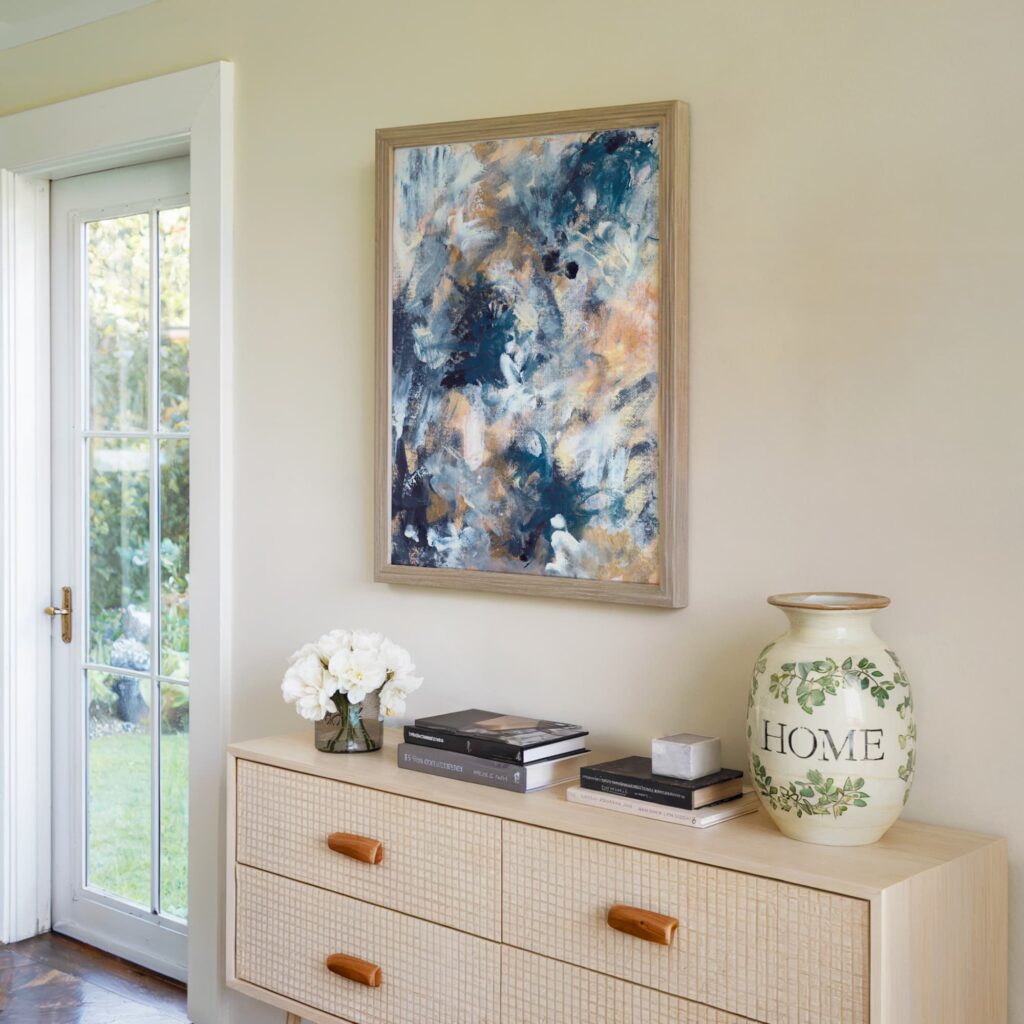
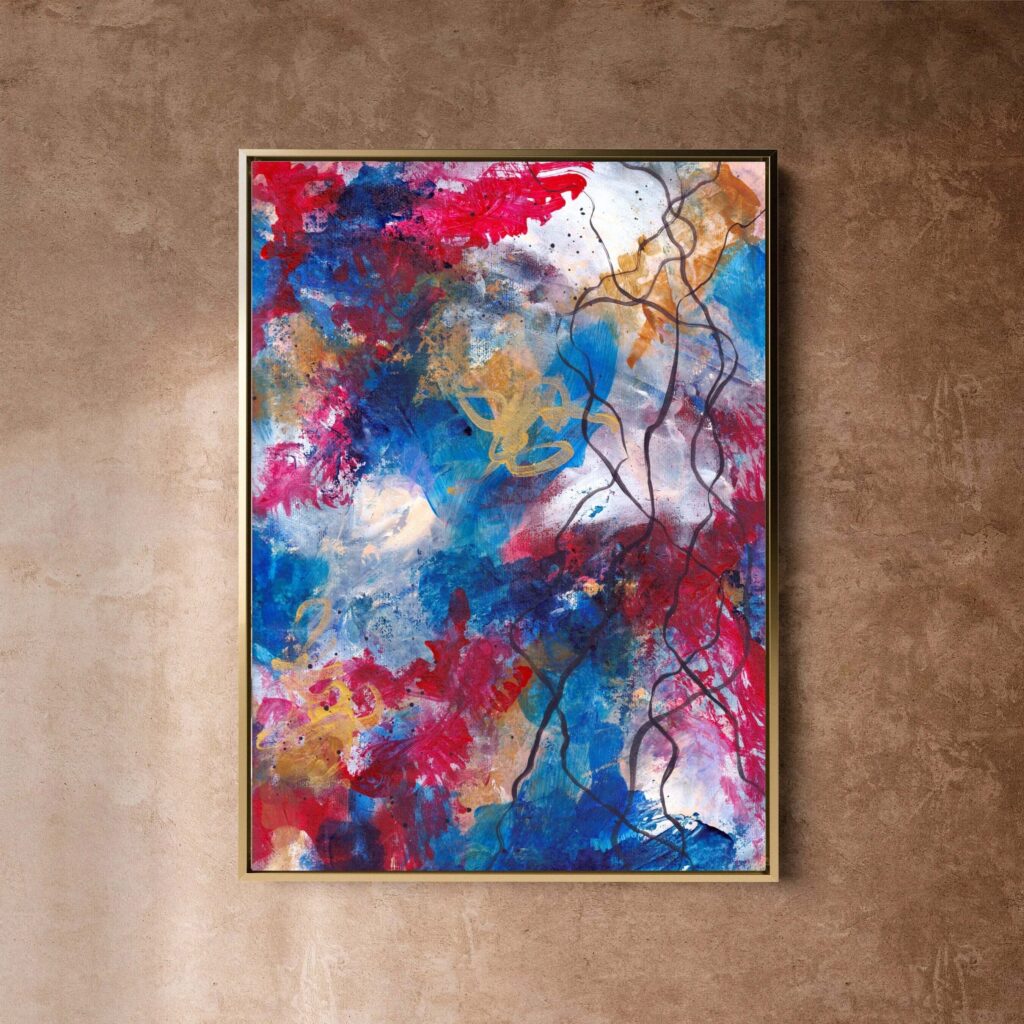
Common Mistakes And How To Avoid Them
Let’s name the most frequent errors, and how to sidestep them. This isn’t just about aesthetics. It’s about emotional clarity and spatial coherence.
Overcrowding
Stuffing a room full of art does one thing: it makes everything feel like noise. No one piece has space to breathe, so none of them get seen.
What to do instead:
Leave negative space intentionally.
Treat each piece like a voice, and give it silence around it to be heard.
Rotate pieces seasonally or quarterly if you want to showcase more than one.
More is not always better. More is often exhausting.
Choosing The Wrong Emotional Tone
A bright, high-energy piece in a room designed for stillness feels jarring. A muted, sombre piece in a lively kitchen feels dissonant.
What to do instead:
Match the mood of the room’s function.
Or, if you’re intentionally contrasting, make sure it’s thoughtful, not accidental.
Ask: Does this feel like it belongs here emotionally, not just visually?
Hanging Too High Or Too Low
Already covered, but worth repeating. Don’t hang for your ceiling. Hang for your body. Stand in the room. See how it meets your eye. That’s where it lives.
Ignoring Scale
A tiny piece in a large room looks like an afterthought. An oversized piece in a tight hallway feels aggressive.
If in doubt:
Cut cardboard or tape the outline directly on the wall first
Photograph the room from a distance with the taped shape visible
Let your eye adjust before making a decision
Skimping On Lighting
A powerful piece in bad lighting is like a brilliant thought whispered in a storm. No one hears it. Honour the art. Light it properly.
Failing To Maintain Art
Remember to care for your art to maintain its beauty and ensure it lasts. To prevent harm, keep the frames dust-free and display the artwork in the right conditions. Avoid exposing your art to excessive humidity or direct sunlight – it will fade, even if there’s a protective layer on it, and the humidity can hurt the integrity of the materials.
Conclusion on integrating abstract art
Integrating abstract art into your home or commercial space is not a superficial act. It’s not about styling. It’s not about keeping up with trends. It’s about emotional authorship. About reclaiming how you want to feel in the spaces that hold your daily life.
The right piece doesn’t just sit quietly on the wall. It alters the room’s rhythm. It speaks on your behalf. It softens the edge of a day. It creates pause where you didn’t know you needed one. That’s the power of emotionally intelligent art.
And abstract work, especially, carries that power with grace. Because it doesn’t dictate meaning. It holds space for your own.
This isn’t about decorating a room. It’s about shifting how that room makes you feel, and how it holds you through your work, your rest, your transitions, your healing.
When you select art with that intention, when you curate your environment like you’d curate a conversation, something quiet but profound happens: your space begins to give back. It no longer demands attention. It offers presence. And in a world that pulls us in a hundred directions, that might be the most powerful kind of luxury.
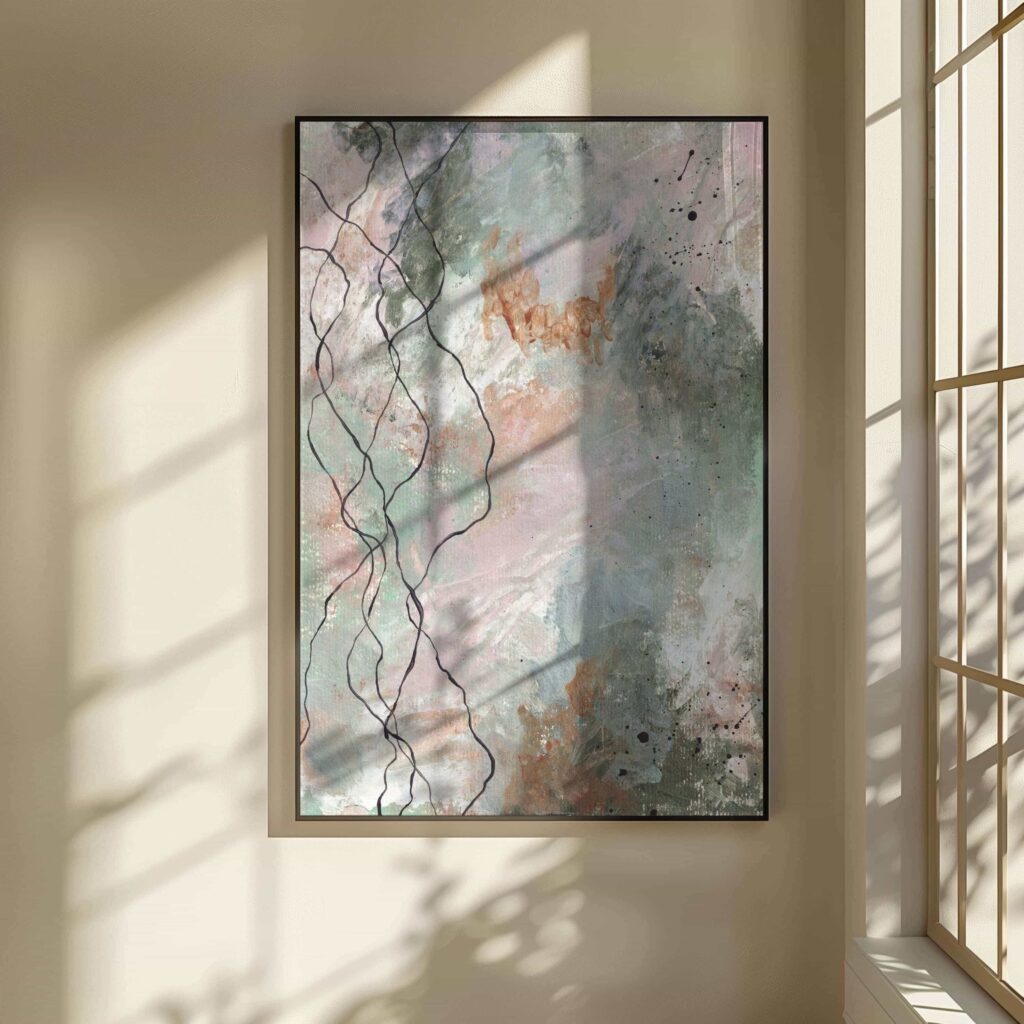
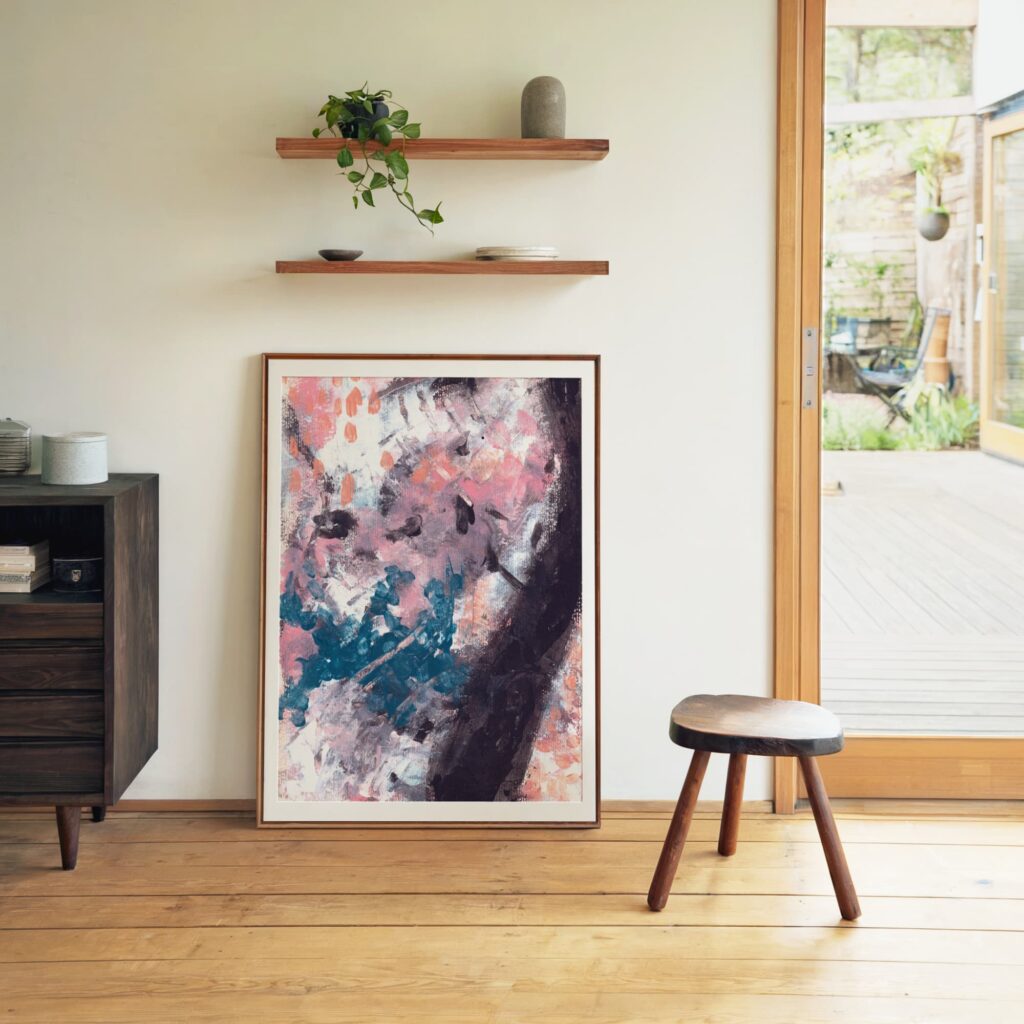
Why I Work In Abstract: Behind The Canvas
Let me tell you something about why I create abstract work.
It’s not because I want to confuse people. It’s not because I think realism is too boring. It’s because abstraction does what words cannot. It lets emotion sit in its rawest form, without labels, without explanation.
I didn’t set out to become an artist. Not like this.
Before this, I was an elite athlete. A long-distance runner. My life was movement, discipline, endurance. It was about the body pushing beyond itself.
But when I burned out, emotionally, physically, psychologically, I came to stillness. And stillness is not a void. It’s a reckoning. It’s where everything you’ve been running from waits for you.
I began painting as a way back to myself. No goal. No performance. Just colour and movement and presence. I needed a place to put what couldn’t be said. So I built that place on canvas. One piece at a time.
What started as recovery became something more: a way to hold space for others. I realised that when people stood in front of my work, they didn’t just see something abstract. They felt themselves reflected back, but softer, gentler, more whole.
Now I create pieces that do just that. Not to impress. But to offer stillness, clarity, or catharsis. Because that’s what art is at its best: not self-expression, but shared experience.
So when I talk about how to bring abstract art into your space, I’m not giving you tips. I’m offering you access. To something deeper, quieter, more true.
How Different Rooms Call For Different Kinds Of Presence
Every room holds a different kind of tension. Different patterns of breath. Different silences. And the art that lives in those rooms should honour that, not disrupt it.
This isn’t about placement tips. It’s about tuning in.
In Spaces That Hold Your Work
In offices, studios, or desks at the edge of the kitchen table, energy is often sharp. Task-driven. Distracted. There’s a low-level static that builds when your mind never stops scanning for what’s next.
Art in these spaces needs to ground.
Not excite. Not distract. Ground.
That doesn’t mean it has to be soft or muted. But it does mean it needs to speak with intention. A piece that helps regulate your nervous system, so you don’t forget to exhale. A colour field that anchors, not performs. Something you can return to when your thoughts start to fragment.
In Spaces That Hold Your Rest
Bedrooms. Recovery corners. Bathing rituals. Late-night silences. These are not passive rooms. They’re places where you put yourself back together.
Here, art needs to do less, but do it with care.
It should feel like breath. Like mist. Like the feeling just before you fall asleep, when the body finally lets go. Cool tones, softened lines, maybe a hint of repetition or texture. The kind of piece that doesn’t ask to be noticed but changes the room once it’s there.
In Spaces That Hold Your Grief Or Healing
These are the hardest rooms to furnish. Sometimes they’re visible, a space you’ve set aside for reflection, journaling, therapy, meditation. Sometimes they’re invisible, it’s the same kitchen you’ve always had, only now it holds absence.
In these spaces, art must be tender.
Not cheerful. Not sterile. Not forced.
Something real. Something layered. Something that doesn’t look away. These are often the pieces I build slowly, layer by layer, because they hold more than colour. They hold emotional memory. And they’re not always beautiful in a traditional sense. But they are honest. And they make it easier to be honest with yourself, too.
In Spaces That Are Meant To Hold Others
Living rooms. Lobbies. Gathering spaces. These are places of conversation, noise, energy. But they also need to hold a centre. A pulse. A thread that steadies the room.
Here, abstract art becomes the quiet host.
It creates coherence in the room without demanding attention. It softens edges. It sparks presence without spectacle. The best pieces here are emotionally clean, not empty, but balanced. They hold a frequency everyone can feel, even if no one can name it.
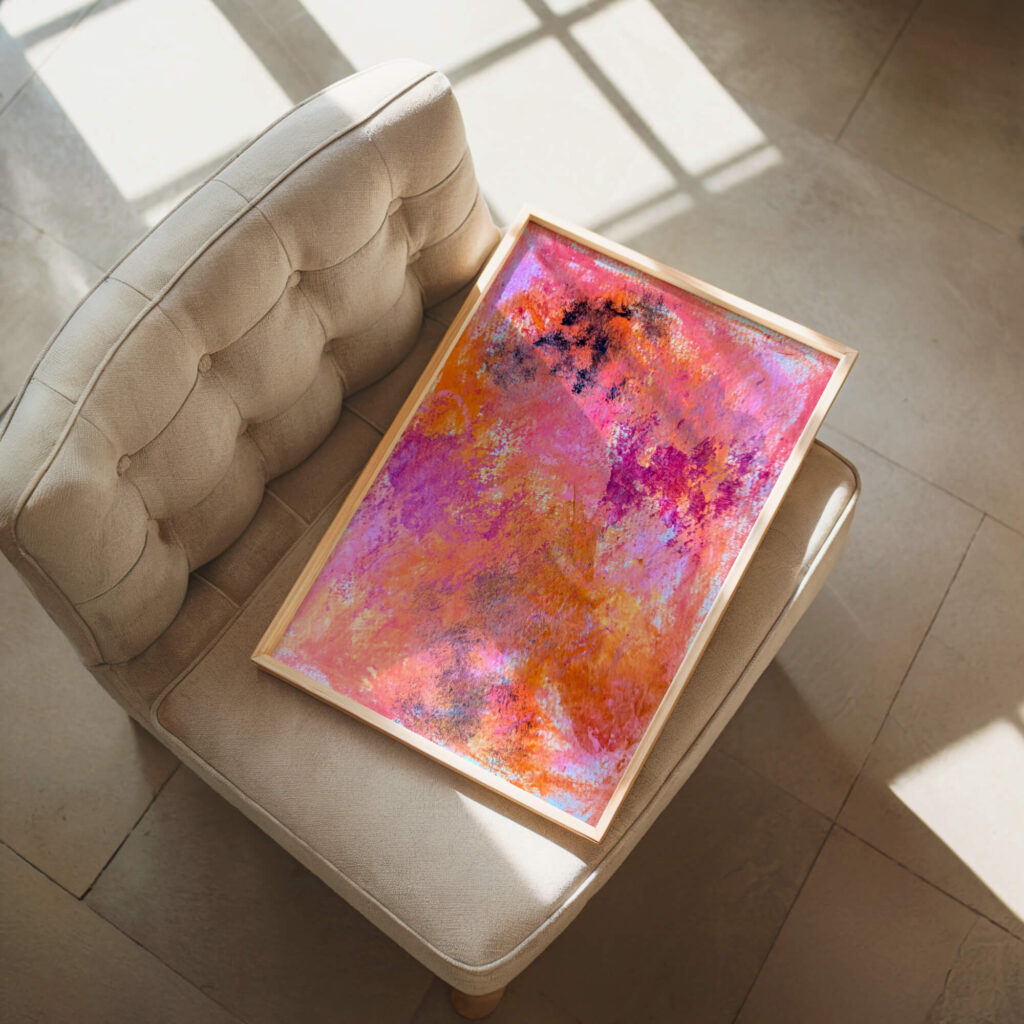
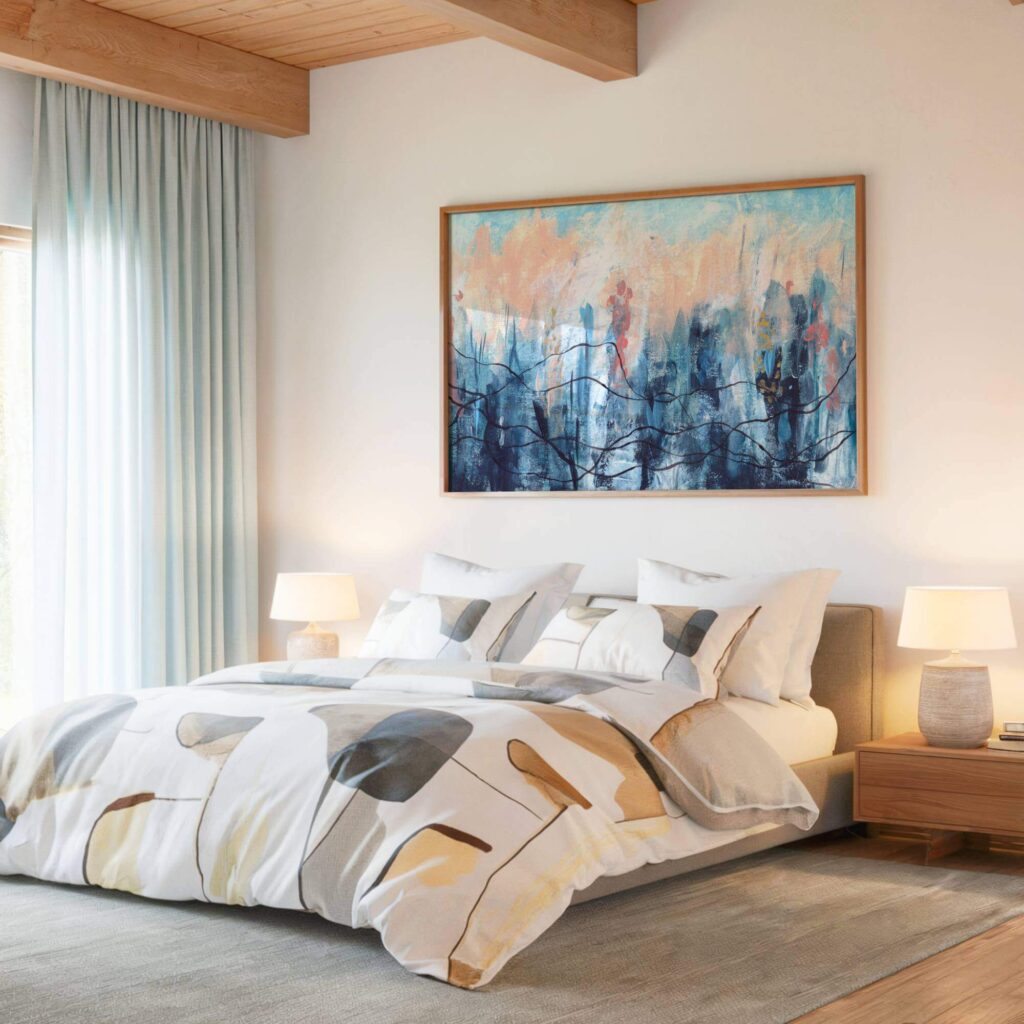
The Studio Process: What Goes Into Each Piece
People sometimes ask what inspires a piece.
They expect me to say a forest, or a feeling, or a particular colour I saw in the sea. But the truth is quieter than that.
It starts with a question.
Not always conscious. Not always articulate. But it’s there, underneath the day. Underneath the noise. Something unresolved. Something pressing against the edges of me.
That’s where a painting begins.
Step One: Listening Before Anything Moves
Before brush, before pigment, before canvas is even stretched, I spend time with the silence. I sit with what’s coming up. With what’s unclear. I don’t plan a composition. I ask: what does this space need to feel? What does this moment want to hold?
Sometimes, I write. Sometimes, I just breathe and wait.
Because if I move too fast, the painting becomes decoration. And that’s not what I’m here to do.
Step One: The First Marks Are Always Wrong
I’ve never had a piece start well. Actually, I don’t think anyone’s first layer is brilliant. The first layers are messy. Awkward. They carry too much force or not enough. That’s part of the work.
I lay pigment down in layers. Pick it up. Let it dry. Add more. I use palette knives, brushes, torn fabric, hands. I drag textures across the surface to see what appears underneath.
Sometimes a shape insists. Sometimes I wipe the whole thing clean.
This is not a linear process. It’s a conversation. One that includes frustration, silence, and sudden clarity.
Step One: Knowing When To Stop
This is the hardest part.
There’s no finish line. There’s only a feeling: that the piece no longer needs me. That it’s standing on its own. That it’s whole, even if it’s imperfect.
When that moment comes, I seal the work. I name it. I sit with it for days before letting it go.
Because each piece, before it’s yours, has to live with me first. It holds parts of my process, my healing, my own stillness. That’s what makes it real.
If You Want To Commission A Piece That Holds Your Story
This part is simple.
Not because it’s light work, it isn’t, but because the process has been made to feel quiet, spacious, human.
Here’s how we begin:
You don’t need to know anything about art.
You don’t need the “right” words. You don’t need a mood board. You just need the desire to create a space that feels like it reflects you, who you are, or who you’re becoming.You answer a few questions.
Gently. Privately. Questions that invite emotional clarity:What are you holding right now?
What kind of energy does your space need more of?
Where in your home or life do you want to feel more like yourself again?
We have a conversation.
Not a consultation. A conversation. About what you want this piece to do. What it needs to hold. What you don’t want anymore in your environment. I’ll guide you through the process.I create the work.
This is where it gets intimate. I’ll send progress updates if you want them. Or not, if you’d prefer to wait and see it complete. It takes time. Weeks, sometimes months. Because I don’t rush. And I don’t repeat.You receive a piece that’s built for your emotional world.
It’s not mass-produced. It’s not designed to impress strangers. It’s built for you. And it will feel like home, even if it surprises you at first.
If you’re creating a space that needs to feel like you, not just look good on a screen, you’re welcome to start here. 👉 Explore the Capsule Commission
No pressure. No fake scarcity. Just one piece, made to hold what matters.
FAQs
- Would I be happy to see this every day, even on a bad day?
- Does it support how I want this room to feel?
- Does it still feel right after I have looked at it several times?
- Big wall, big energy: one large piece or a strong diptych will usually feel more grounded than lots of small works scattered around.
- Medium spaces: pairs or triptychs work well over sofas, sideboards and beds.
- Narrow spaces: tall, vertical works can elongate hallways and awkward corners.
- In minimalist spaces, it adds depth and warmth.
- In maximalist spaces, it creates breathing room.
- In very traditional or period interiors, it can be the unexpected contemporary element that keeps the room from feeling like a museum.
- Consistency: Does the artist’s wider body of work feel coherent, or is it all over the place? Strong work usually comes from a clear practice, not a one-off experiment.
- Structure: Even in the loosest piece, look for some underlying order: balance of light and dark, areas of rest vs complexity, a sense that nothing is accidentally awkward.
- Feeling over time: Do you keep thinking about the piece after you have walked away? If it stays with you, it is doing its job.
- Fit: Does it genuinely support how you want your space to feel, or are you trying to talk yourself into it because it looks clever?
